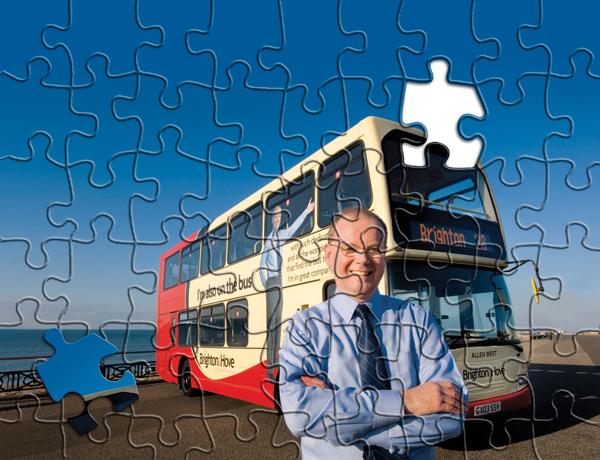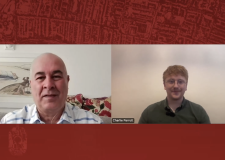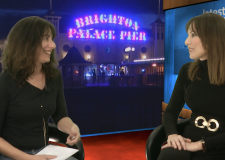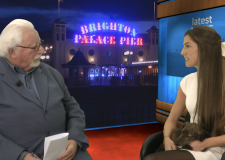Brighton bus boss retires after 30 years in the driving seat
Bus boss Roger French gave an entertaining farewell speech to the great and good of Brighton and Hove. Frank le Duc reports

One of the best known people in Brighton and Hove retires in a few weeks’ time. Roger French, the managing director of Brighton and Hove Buses, has spent 30 years in the driving seat.
But he wears a number of other hats too. He is also stepping down as chairman of a much-loved local institution, The Martlets Hospice. And until last week he had spent almost eight years as the chairman of another much less well-known body, the Brighton and Hove Strategic Partnership.
At his final meeting he shared some parting reflections with his colleagues on the local strategic partnership. Those colleagues include the great and the good of Brighton and Hove. He spoke frankly about the challenges facing those who run our city and praised the fantastic spirit of volunteering that enriches life in our communities.
Mr French, 58, said: “As we aspire to be a digital city and indeed have an emerging digital inclusion strategy, allow me to use an analogy likening our wonderful city as if it comprises hardware, software and operating systems.
“The hardware would be the infrastructure and physical issues we know and love so well – the Downs and the sea – leading to the limited space conundrum. The software would be the social and human issues. And the operating systems would be the way the software and hardware work together – a good example being this august body – the strategic partnership and its family of thematic partnerships.”
Strong points
“One of our strong points is a realistic attitude to the challenges we face as a city. Probably every city has its particular set of challenges and we are particularly good at understanding what we face.
“On the hardware, infrastructure front, as well as the restricted spatial issues, we also have the challenge of restricted road space and rail lines limited by track and signal capacity and, to the west, by level crossing frustrations.
“Here is a classic example though of using space effectively and making the best of what we have – the A27 bypass, built 20 years ago. It’s no coincidence that its construction was a significant factor in releasing road space closer to the centre to encourage bus use. And uniquely over the last 20 years we have doubled the already significant bus use in the city and now have the most intensively used buses per head of population outside of London.
“Other conceptually similar challenges to our travel needs surround our housing needs. Restricted building in the 1980s onwards has left us with large swathes of HMOs (houses in multiple occupation) and a large private rental sector which, with the huge expansion of the city’s two universities and the need for student accommodation, has led to a shortfall of family homes.”
He said that those housing problems were exacerbated by a “red flag” issue – a lack of progress in the past in meeting the decent homes standard in the social housing sector. He said: “This, as we knew, was being addressed and continues to be addressed effectively but the underlying problem of a lack of housing continues, pushing house prices and rental prices up to drive out more people to live in an ever increasing catchment area, which coincidentally adds to our transport challenges.”
Red doesn’t mean stop
“Other hardware issues we know and love are those of office quality to attract and retain the businesses and jobs we want to see and, as the trend for online shopping increases, the large amount of retail – once our strength in attracting shoppers from around the region to such a diverse and eclectic mix of shops.
“Vacancy rates are still at levels northern towns like Bolton and Gateshead would die for – but it is potentially an issue for the future as there are only so many coffee shops, restaurants, convenience stores, beauty and nail parlours and, dare I say, betting shops and charity shops that the market can bear.
“On the upside we bucked the trend for out-of-town retail and business parks which have been so damaging to the vibrancy of city centres in other places, meaning we do have a vibrant city centre which, with its ideal location next to the sea, has done us proud in keeping that attractive offer viable. We must ensure we continue to nurture that and plans for the Brighton Centre and further enhancement of the environment, to make the retail, cultural and hospitality offer world class, are welcomed.
“Which brings me to the software issues,” he said. Referring to “rag ratings” – red, amber and green traffic lights on management and monitoring reports – he added: “There was a time when I thought I knew what traffic lights were for. Now I see them in an entirely different light. Red doesn’t mean stop. It means we’ve got an issue with teenage pregnancies, or education attainment, alcohol abuse, a skills and jobs imbalance, areas of deprivation and inequality… or it may just mean we lack the right monitoring data!
“But just like the hardware issues, the upside is we’re aware of our shortcomings and challenges and are doing all we can to address them. With the glass half full, we also have our green traffic lights, and indeed once got a green flag for our night-time economy and how we manage the challenges that it brings to provide a successful model for others to aspire to.
“It may not seem like it in A&E in the early hours of Saturday and Sunday mornings but we do well as a city in this key part of the local economy. I personally just wish it wasn’t so dependent on alcohol and have concerns of the impact this has, perhaps more so than drugs, on impeding the city finding its potential.
Strategic partnerships
“The most positive piece of ‘software’ is of course, the hugely welcome results of our ‘city tracker’ and ‘place’ surveys – the fact that 90 per cent of us are satisfied rising to 93 per cent satisfaction with the local area in which we live is an enormous accolade. For a public sector organisation such as a city council to achieve 70 per cent satisfaction is hugely creditable and something to celebrate and acknowledge as a success.
“You also have to have the right operating systems and that is where we come in. This strategic partnership is one part of our operating system and has become a huge strength since its formation in 2001. It’s by no means the only strength – indeed in the grand scheme of things it’s a relatively minor cog in the overall system – but reflecting on what we’ve discussed, debated, approved and signed off over the years, it’s been quite an achievement.
“We’ve become adept at approving strategies – getting on for 15 in the last seven to eight years – from volunteering to food, community engagement, the economy, employment and skills and housing. We’ve also discussed and approved a whole host of programmes, reviews and assessments, not forgetting Tom Scanlon’s excellent annual health reports. Where else would all these joining up issues be debated? Nowhere.
“Before we blow our own trumpet too much, the operating systems comprise so much more of course. Indeed, more important are the constituent parts of the partnership – the local authority in particular. Amid many changes the strategic partnership has brought stability and continuity to the operating systems where they need to work together for the good of the city.
“If I may conclude these remarks with another analogy, it would be of a jigsaw. We’re the custodians of a beautiful picture that’s on the cover of the box – our vision of how, through consultation, we want this city to be. But there are 1,000 pieces inside the box that all need to fit carefully together to make that picture – the vision, if you will.
“To complete that vision takes effort and sometimes the wrong bits keep being picked up. But if we’re patient and work hard we will achieve it and see how the pieces do fit together. Just like a jigsaw with one piece missing, when the picture is spoilt, so it is with running a city without its constituent parts working together in a true partnership each playing to their strengths.”
Brighton & Hove City Council leader Jason Kitcat on SONORUS
What does Brighton & Hove sound like to you? Do you think of the waves breaking on the beach, the chatter of crowds in the city centre on a weekend, or the drone and rumble of vehicles on our main roads? Sound in our environments has been a growing area for research around the world, especially in urban areas where residents tend to live, work and play in close quarters.
To do some more work in this area, we’re one of four cities involved in SONORUS, a European-funded project led by Chalmers University in Gothenburg, Sweden. SONORUS brings together 14 researchers and representatives from Brighton & Hove, Berlin, Antwerp, and Rome to look at the impact noise has on residents, and how the ‘soundscape’ can be improved. Also involved are the Noise Abatement Society, independent experts and an academic from Brighton University.
Through this project we’ll be able to share information on how urban sounds can be controlled, areas protected and shielded, and how noise from developments such as new buildings, or increased road traffic, can be planned for. It will build on projects we’ve already run in the city including on the busy night-time experience on West Street.
We know that noise nuisance can have significant impacts on people’s physical and mental health through stress, sleep disturbance and changing how people behave in public spaces. During the pilot on West Street the Police reported needing far fewer officers as crowds behaved better when experiencing a different soundscape.
At a time when we are improving a range of open and public spaces – such as Valley Gardens, Providence Place and The Level – we will be able to include ways to reduce noise nuisance for residents in the process. This kind of work helps to significantly improve residents’ quality of life in the city.




















